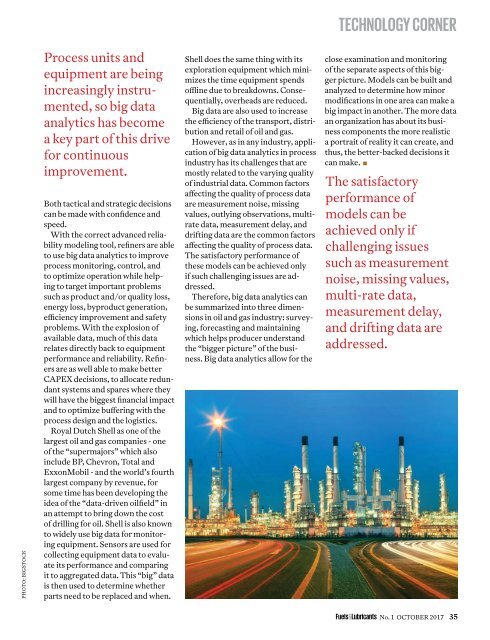Fuels & Lubricants Magazine
Issue 1, October 2017
Issue 1, October 2017
You also want an ePaper? Increase the reach of your titles
YUMPU automatically turns print PDFs into web optimized ePapers that Google loves.
Technology Corner<br />
PHOTO: Bigstock<br />
Process units and<br />
equipment are being<br />
increasingly instrumented,<br />
so big data<br />
analytics has become<br />
a key part of this drive<br />
for continuous<br />
improvement.<br />
Both tactical and strategic decisions<br />
can be made with confidence and<br />
speed.<br />
With the correct advanced reliability<br />
modeling tool, refiners are able<br />
to use big data analytics to improve<br />
process monitoring, control, and<br />
to optimize operation while helping<br />
to target important problems<br />
such as product and/or quality loss,<br />
energy loss, byproduct generation,<br />
efficiency improvement and safety<br />
problems. With the explosion of<br />
available data, much of this data<br />
relates directly back to equipment<br />
performance and reliability. Refiners<br />
are as well able to make better<br />
CAPEX decisions, to allocate redundant<br />
systems and spares where they<br />
will have the biggest financial impact<br />
and to optimize buffering with the<br />
process design and the logistics.<br />
Royal Dutch Shell as one of the<br />
largest oil and gas companies - one<br />
of the “supermajors” which also<br />
include BP, Chevron, Total and<br />
ExxonMobil - and the world’s fourth<br />
largest company by revenue, for<br />
some time has been developing the<br />
idea of the “data-driven oilfield” in<br />
an attempt to bring down the cost<br />
of drilling for oil. Shell is also known<br />
to widely use big data for monitoring<br />
equipment. Sensors are used for<br />
collecting equipment data to evaluate<br />
its performance and comparing<br />
it to aggregated data. This “big” data<br />
is then used to determine whether<br />
parts need to be replaced and when.<br />
Shell does the same thing with its<br />
exploration equipment which minimizes<br />
the time equipment spends<br />
offline due to breakdowns. Consequentially,<br />
overheads are reduced.<br />
Big data are also used to increase<br />
the efficiency of the transport, distribution<br />
and retail of oil and gas.<br />
However, as in any industry, application<br />
of big data analytics in process<br />
industry has its challenges that are<br />
mostly related to the varying quality<br />
of industrial data. Common factors<br />
affecting the quality of process data<br />
are measurement noise, missing<br />
values, outlying observations, multirate<br />
data, measurement delay, and<br />
drifting data are the common factors<br />
affecting the quality of process data.<br />
The satisfactory performance of<br />
these models can be achieved only<br />
if such challenging issues are addressed.<br />
Therefore, big data analytics can<br />
be summarized into three dimensions<br />
in oil and gas industry: surveying,<br />
forecasting and maintaining<br />
which helps producer understand<br />
the “bigger picture” of the business.<br />
Big data analytics allow for the<br />
close examination and monitoring<br />
of the separate aspects of this bigger<br />
picture. Models can be built and<br />
analyzed to determine how minor<br />
modifications in one area can make a<br />
big impact in another. The more data<br />
an organization has about its business<br />
components the more realistic<br />
a portrait of reality it can create, and<br />
thus, the better-backed decisions it<br />
can make.







